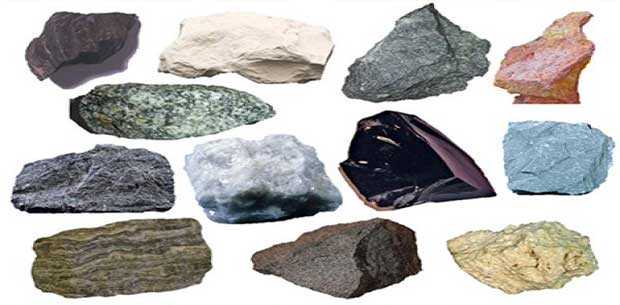
The rocks from which the building stones are obtained are classified in the following three ways:
A. Geological classification
Based upon how they are formed and the geological process involved in it, rocks are classified into following three types:
Igneous rocks
These are formed by cooling the molten lava on or inside the earth’s surface during volcanic eruption. They don’t contain any fossils or shells. The rocks may be acidic or alkaline depending upon silica content.
- When magma is forced up as volcanic eruptions and spreads over the surface of earth where it solidifies, it forms basalt and trap. These are known as effusive rocks.
- If the magma solidifies below the earth’s surface itself, the solid crystalline rock is termed as deep-seated plutonic rock. The examples are granite, syenite, diorite and gabbro.
- If the magma solidifies at a relatively shallow depth, the resultant rock possesses a finely grained crystalline structure—and is termed as hypabyssal rock. Dolerite is such a rock.
- The principal constituents of magma are quartz, mica and felspar.
| Type | % of Silica | Example |
| Acid rocks | 70-80 | Granite, Rhyolite |
| Intermediate rocks | 60-70 | Syenite, Ana’esite |
| Basic rocks | 45-60 | Gabbro, Dolerite |
| Ultra-basic rocks | 30-45 | Peridotite, Basalt |
Sedimentary rocks
These are formed by gradual deposition of disintegrated rocks at the bottom of rivers, lakes or sea.
- Sedimentary rocks resulting from the precipitation of salts in drying water basin (chemical deposits) are gypsum, anhydrite, magnesite, dolomite, lime tufas.
- Sedimentary rocks resulting from the accumulation of plant or animal remains (organogenous rocks) are limestone, shale, chalk, diatomite and tripoli.
- The examples of rocks resulting from the deterioration of massive magmatic or sedimentary rocks (fragmental rocks) are sandstone, laterite, sand, gravel, carbonate conglomerate and breccia.
Metamorphic rocks
These are formed when sedimentary or igneous rocks are subjected to great heat and pressure inside the earth. The metamorphic process causes a complete recrystallization of the original rock into an interlocking mosaic of calcite, aragonite and/or dolomite crystals.
| Original rock | Metamorphic rock | Original rock | Metamorphic rock |
| Granite | Gneiss | Shale | Slate, Schist, Phyallite |
| Syenite | Gneiss | Laterite and Granite | Schist |
| Sandstone | Quartzite | Dolomite | Marble |
| Limestone and Marl | Marble, Schist | Dolerite, Basalt, Trap | Schist |
| Mudstone | Slate | Felsite, Tuff | Schist, Slate |
| Conglomerate | Gneiss, Schist | Claystone | Hornblende |
B. Physical/ Petrological classification
Based upon the physical properties and alignment, rocks may be classified into following types:
- Stratified rocks are those which exhibit distinct layers which can be separated. The plane along which the separation of the layers can be carried out is called as the cleavage plane.
Examples: Limestone, Slate, Sandstone etc.
- Unstratified rocks do not show any sign of strata and cannot be easily split into the slabs.
Examples: Granite, Trap etc.
- Foliated or fragmented rocks have a tendency to split up only in a definite direction. Most of the metamorphic rocks have a foliated structure, except for quartzite and marble which have granulose structure.
C. Chemical classification
Based upon the chemical composition, rocks may be classified into following types:
- Silicious rocks are those which have silica as the main constituent. The silica in the free state is called sand and in combined state is silicate.
Examples: Granite, Quartzite, Sandstone etc.
- Argillaceous rocks are those which have clay or alumina as the main constituent.
Examples: Kaolin, Laterite, Slate etc.
- Calcareous rocks have calcium carbonate or lime as their leading constituent. These rocks are readily acted upon by even dilute HCl.
Examples: Limestone and Marble.
